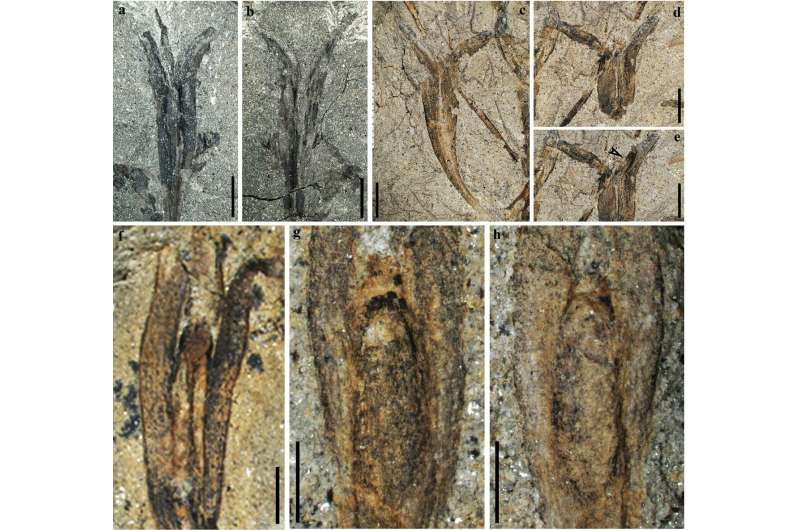Researchers in China have discovered one of the earliest examples of a winged seed, dating back 365 million years. This remarkable find sheds new light on the evolution of wind dispersal in ancient plants. The seed, named Alasemenia, had three wing-like structures, providing superior dispersal capabilities compared to earlier winged seeds with two or four wings. This discovery adds valuable insights to our understanding of the origins of seed-based plant reproduction and the role of wind in their dispersal. Seed dispersal is a critical evolutionary adaptation that allows plants to colonize new territories and reduce competition for resources.

Unlocking the Secrets of Ancient Plant Evolution through Winged Seed Discovery
The discovery of the Alasemenia seed in a mine in Anhui Province, China, has provided a glimpse into the evolutionary history of plants and their methods of seed dispersal. This newly identified species is one of the earliest known examples of a winged seed, dating back to the Late Devonian period, approximately 365 million years ago.
Unlike earlier winged seeds that had two or four wings, Alasemenia showcased a unique three-wing design. This structural feature likely gave the seed enhanced wind dispersal capabilities, allowing it to travel longer distances and reduce competition with other plants. The researchers suggest that this adaptation may have provided Alasemenia with a competitive advantage, enabling it to colonize new habitats and thrive during a critical period in plant evolution.
The discovery of Alasemenia adds to our understanding of the evolution of plants and their reproductive strategies. Prior research has shown that the first seeds evolved approximately 372 to 359 million years ago, during the Famennian stage, emerging from earlier spore-based reproduction. The initial seeds, however, were covered by a cupule and did not possess wings, indicating that the development of winged seeds came later in the evolutionary timeline.
Exploring the Adaptive Advantages of Winged Seeds: Insights from the Alasemenia Discovery
The discovery of Alasemenia in the Jianchuan mine in Anhui Province, China, has shed light on the adaptive advantages of winged seeds during the Late Devonian period.
Winged seeds are a remarkable evolutionary adaptation that allows plants to take advantage of wind dispersal, enabling their seeds to travel further and colonize new areas. This dispersal mechanism is crucial for reducing competition between plants and ensuring the survival of the species.
Prior to the discovery of Alasemenia, only two plant groups were known to have developed wings during the Famennian stage, which is the Late Devonian period. The Alasemenia seed, with its unique three-wing design, provides new insights into the evolution of wind dispersal in ancient plants.
According to the researchers, the three-wing structure of Alasemenia likely provided a more stable flight and faster spin compared to earlier winged seeds with two or four wings. This enhanced dispersal ability may have given Alasemenia a significant competitive advantage, allowing it to travel longer distances and occupy new ecological niches.
The study of Alasemenia and other ancient winged seeds contributes to our understanding of the mechanisms of seed dispersal and the role they played in the colonization of new environments by early plant species.
Unraveling the Evolutionary Significance of the Alasemenia Discovery
The discovery of Alasemenia, the earliest known example of a winged seed with three wing-like structures, holds significant evolutionary implications. This finding adds to the growing body of evidence regarding the origins and development of wind dispersal in ancient plant species.
Prior to the discovery of Alasemenia, the earliest known winged seeds had either two or four wings. The unique three-wing design of Alasemenia suggests that multiple evolutionary pathways may have led to the development of winged seeds, with each variation offering distinct advantages in terms of dispersal and survival.
By analyzing the dispersal capabilities of Alasemenia and comparing it to earlier winged seeds, the research team was able to hypothesize that the three-wing structure provided a more stable and efficient flight, allowing the seed to travel further when carried by the wind. This enhanced dispersal ability may have given Alasemenia a competitive edge over other plant species, enabling it to colonize new habitats and thrive in the Late Devonian period.
The discovery of Alasemenia not only adds to our understanding of the evolution of plants and their reproductive strategies but also highlights the importance of continuous exploration and scientific discovery in unveiling the mysteries of the natural world.
